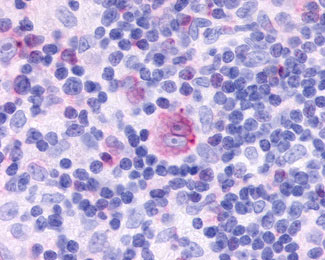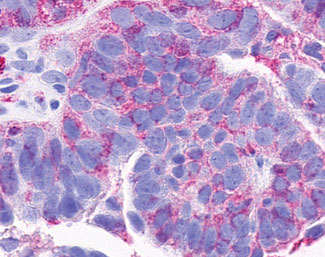CCRL2 Antibody (Cytoplasmic Domain)
Rabbit Polyclonal Antibody
- SPECIFICATION
- CITATIONS
- PROTOCOLS
- BACKGROUND

Application
| IHC-P |
|---|---|
| Primary Accession | O00421 |
| Reactivity | Human |
| Host | Rabbit |
| Clonality | Polyclonal |
| Calculated MW | 40kDa |
| Dilution | IHC-P (11 µg/ml) |
| Gene ID | 9034 |
|---|---|
| Other Names | C-C chemokine receptor-like 2, Chemokine receptor CCR11, Chemokine receptor X, Putative MCP-1 chemokine receptor, CCRL2, CCR11, CCR6, CKRX, CRAM, HCR |
| Target/Specificity | Human CCRL2. BLAST analysis of the peptide immunogen showed no homology with other human proteins. |
| Reconstitution & Storage | Long term: -70°C; Short term: +4°C |
| Precautions | CCRL2 Antibody (Cytoplasmic Domain) is for research use only and not for use in diagnostic or therapeutic procedures. |
| Name | CCRL2 |
|---|---|
| Synonyms | CCR11, CCR6, CKRX, CRAM, HCR |
| Function | Receptor for CCL19 and chemerin/RARRES2. Does not appear to be a signaling receptor, but may have a role in modulating chemokine- triggered immune responses by capturing and internalizing CCL19 or by presenting RARRES2 ligand to CMKLR1, a functional signaling receptors. Plays a critical role for the development of Th2 responses. |
| Cellular Location | Cell membrane; Multi-pass membrane protein |
| Tissue Location | Expressed abundantly in immunal tissues such as spleen, fetal liver, lymph node and bone marrow. Strong expression also in lung and heart. Expressed in almost all hematopoietic cells including monocytes, macrophages, PMNs, T-cells (both CD4+ and CD8+), monocyte-derived iDCs, NK cells, and CD34+ progenitor cells. B-cells expressed isoform 1 but not isoform 2. Up-regulated on synovial neutrophils of rheumatoid arthritis patients |
| Volume | 50 µl |

Thousands of laboratories across the world have published research that depended on the performance of antibodies from Abcepta to advance their research. Check out links to articles that cite our products in major peer-reviewed journals, organized by research category.
info@abcepta.com, and receive a free "I Love Antibodies" mug.
Provided below are standard protocols that you may find useful for product applications.
Background
Receptor for CCL19 and chemerin/RARRES2. Does not appear to be a signaling receptor, but may have a role in modulating chemokine-triggered immune responses by capturing and internalizing CCL19 or by presenting RARRES2 ligand to CMKLR1, a functional signaling receptors. Plays a critical role for the development of Th2 responses.
References
Fan P.,et al.Biochem. Biophys. Res. Commun. 243:264-268(1998).
Ansari-Lari M.A.,et al.Submitted (JUL-1997) to the EMBL/GenBank/DDBJ databases.
Gish K.,et al.Submitted (JUL-1997) to the EMBL/GenBank/DDBJ databases.
Biber K.P.H.,et al.Submitted (AUG-2001) to the EMBL/GenBank/DDBJ databases.
Ota T.,et al.Nat. Genet. 36:40-45(2004).
If you have used an Abcepta product and would like to share how it has performed, please click on the "Submit Review" button and provide the requested information. Our staff will examine and post your review and contact you if needed.
If you have any additional inquiries please email technical services at tech@abcepta.com.













 Foundational characteristics of cancer include proliferation, angiogenesis, migration, evasion of apoptosis, and cellular immortality. Find key markers for these cellular processes and antibodies to detect them.
Foundational characteristics of cancer include proliferation, angiogenesis, migration, evasion of apoptosis, and cellular immortality. Find key markers for these cellular processes and antibodies to detect them. The SUMOplot™ Analysis Program predicts and scores sumoylation sites in your protein. SUMOylation is a post-translational modification involved in various cellular processes, such as nuclear-cytosolic transport, transcriptional regulation, apoptosis, protein stability, response to stress, and progression through the cell cycle.
The SUMOplot™ Analysis Program predicts and scores sumoylation sites in your protein. SUMOylation is a post-translational modification involved in various cellular processes, such as nuclear-cytosolic transport, transcriptional regulation, apoptosis, protein stability, response to stress, and progression through the cell cycle. The Autophagy Receptor Motif Plotter predicts and scores autophagy receptor binding sites in your protein. Identifying proteins connected to this pathway is critical to understanding the role of autophagy in physiological as well as pathological processes such as development, differentiation, neurodegenerative diseases, stress, infection, and cancer.
The Autophagy Receptor Motif Plotter predicts and scores autophagy receptor binding sites in your protein. Identifying proteins connected to this pathway is critical to understanding the role of autophagy in physiological as well as pathological processes such as development, differentiation, neurodegenerative diseases, stress, infection, and cancer.



